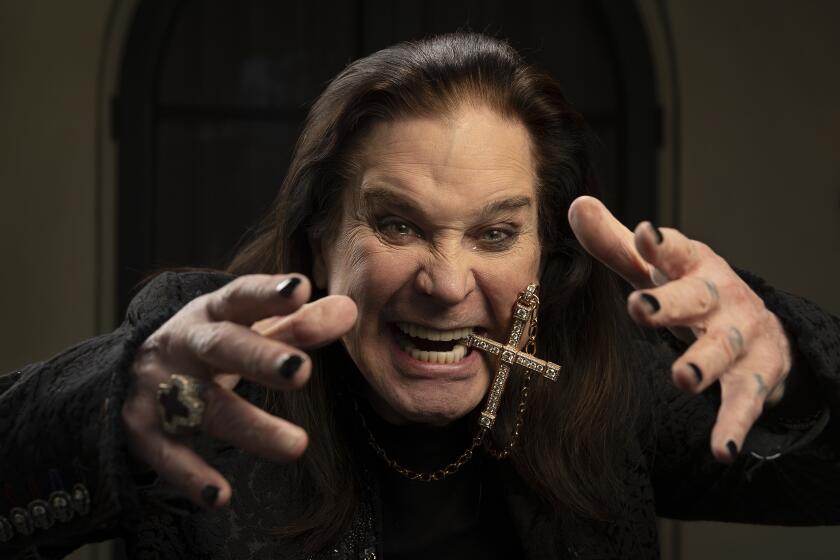‘Figurative’ Draws Wonder From Some Elementary Means
- Share via
It’s the kind of small museum exhibition many visitors pass unnoticed. On view at the Museum of Contemporary Art, its premise is explained by the title “Notes on the Figurative: Graphic Works From the Permanent Collection.” About the only thing left unsaid by that is that a couple of works qualify as sculpture.
Numerically we’re faced with no more than 14 objects by nine artists in one modestly proportioned gallery. There are advantages to such compression. It offers the opportunity to spend more moments-per-work than usual without really taking up a bothersome amount of time. We’re reminded that, with art as with most things, the more you pay attention, the more you are rewarded.
The show was thoughtfully organized by MOCA assistant curator Connie Butler. Her simple title suggests something to do with “the figure.” For most people that may connote the human figure. In artspeak, however, “the figure” means anything that’s not the background. “The background,” however, does not merely denote the leftover stuff that’s not the figure. In the classroom it’s called “negative space” and is regarded as having equal weight with the figure that--to balance the equation--is termed “positive space.” Reduced to the virtually abstract mathematical formula that underlies all artistic composition, the two elements are essentially interchangeable.
The principle is aptly illustrated by Jill Giegerich’s “Untitled (brass lamp),” certainly the most visually striking thing here. It depicts a life-size, old-fashioned table lamp executed in outline by welded brass rod. Hung, the enclosing rods activate the neutral “negative” space of the wall into the “positive” volume of the lamp.
In short Butler’s unprepossessing show encourages contemplation of art’s most fundamental structural elements. She moves back from the sophisticated notion of the so-called “figure/ground” relationship to the only basic means the artist has of creating that relationship. There is no way to do it except by somehow making a mark. Basically that hasn’t changed since the cave artists. Marks take two fundamental forms--blobs and lines.
The most refined example of this primitive fact is seen in two portrait drawings by David Hockney. One depicts a young chap named David Lilgh who looks like a masculine version of a femme fatale. The other shows Hockney’s late friend Henry Geldzahler. His beard, glasses and general demeanor keep him looking dignified despite the fact he is buck-naked.
Hockney encourages us to react to these images as if the people were really present. He does this by minimizing the assertiveness of his means. His line is wire-thin, his blobs smudged into the suggestion of shadow.
Other artists who actually depict the human figure variously combine and reconfigure line and blob to achieve remarkable expressive variation. Richard Diebenkorn balanced a drawing of a woman in an armchair so deftly between depiction and abstraction as to achieve a casual classical balance. George Segal’s similar subject is less abstracted. Varied in four panels it suggests the idea of time, augmenting Segal’s humanism. Philip Guston’s late, Gully Jimson-style absurdist humor is hung on images where rational line constantly hiccups into expressive splatters. In short, the concept of style that seems so much the ornamental blossom of civilization arises from the most elemental procedures.
*
Lest we forget and assume from all this that art is something imposed on us from the outside, Butler brings in some works by Joel Shapiro. He specializes in manipulating very basic forms in a fashion that evokes other images in the viewer’s mind. The leitmotif of one work, for example, is nothing more than several bands of black formed in right angles. They touch one another in a way that suggests an upright, two-legged creature with a tail. Try as we may to keep the marks in proper perspective, it’s impossible not to read them as ape or satanic specter. We are all victims of our own perceptual mechanism.
Terry Winters plays on our propensity for mental slippage with a curious “Dark Plants 7” that looks like a cross between a cobra and the head of a golf club. St. Clair Cemin is represented by a blob of bronze with a knife blade affixed. It’s impossible to tell if the blob is the handle of the blade or a thing it pierces. Just when one is about to give up on the idea of abstraction uncontaminated by perception Elizabeth Murray provides relief in a couple of blobs that are just blobs.
It’s been said that the making of art probably involves no more than a couple of dozen rudimentary actions, each of which seems dumber than the last. Properly combined, however, the result can be a Jackson Pollock or the Sistine Ceiling. This modest little exhibition acts to recall the wonder of that.
* Museum of Contemporary Art, 250 S. Grand Ave.; through Aug. 3, closed Mondays, (213) 621-2766.
More to Read
The biggest entertainment stories
Get our big stories about Hollywood, film, television, music, arts, culture and more right in your inbox as soon as they publish.
You may occasionally receive promotional content from the Los Angeles Times.










